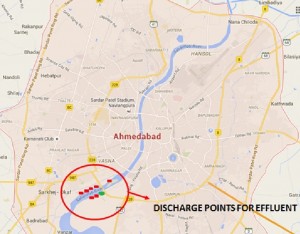 Last week I was
Last week I was in India, in the city of Ahmedabad, standing on a bridge over the river Sabarmati. The sun is shining bright and the view over the river basin is incredible. I had just returned from a full program of excursions organized by people from an environmental educational platform. I was lucky to have the opportunity to see several types of factories in the clothing industry. We were told that these factories will only get permission to start if they work according to several environmental regulations, one of which is they have to transform part of their land property into a garden, see the photo.
in India, in the city of Ahmedabad, standing on a bridge over the river Sabarmati. The sun is shining bright and the view over the river basin is incredible. I had just returned from a full program of excursions organized by people from an environmental educational platform. I was lucky to have the opportunity to see several types of factories in the clothing industry. We were told that these factories will only get permission to start if they work according to several environmental regulations, one of which is they have to transform part of their land property into a garden, see the photo.
The first factory we visited uses acid and lime to produce gypsum and as a by-product they produce dye which is used in the colouring process of textiles. At this factory it was very difficult to breath due to the acid clouds hanging over our heads and several of us were coughing along the way, despite the fact that we were wearing protective mouth caps. Of course it looks different than western standards, but I can tell you it is very well organized and the process is quite efficient in terms of re-use of products. This is beneficial from an economic and environmental perspective.
The second factory we visited was a dying factory, which unfortunately did not allow camera’s inside. In this factory the dye produced in the first factory is used to colour textiles according to a specific design. They have a design team that works with the client to make sure the clothes are printed correctly. We passed a lot of colourful designs with flowers, strips, dots, faces, animals and many more. 3 different methods can be used for printing: plate pressing, roll printing and digital printing. Before and after printing the textiles are washed thoroughly with water and steam. The whole factory smelled like paint and there is no air freshening anywhere. There are some small windows but they don’t really help. All the dyes are stored in open vessels beside the working area and the people working here are not using any protective clothing. Combined with the heat it is not a very pleasent environment to work in…

 These two factories produce a severe amount of wastewater containing heavy chemicals. Part of the treatment happens on site and after this it is transported to a Central Effluent Treatment Plant (CETP), which is the third place we visited. The CETP is designed to reduce very basic water quality indicators (COD, BOD, TSS and perhaps some other things but it was difficult to completely understand the story). It might not seem like much, especially considering this wastewater contains so many industrial chemicals, but the people here seem to be really trying.
These two factories produce a severe amount of wastewater containing heavy chemicals. Part of the treatment happens on site and after this it is transported to a Central Effluent Treatment Plant (CETP), which is the third place we visited. The CETP is designed to reduce very basic water quality indicators (COD, BOD, TSS and perhaps some other things but it was difficult to completely understand the story). It might not seem like much, especially considering this wastewater contains so many industrial chemicals, but the people here seem to be really trying.
From the CETP the wastewater is transported to a discharge point, see the video. On the Sabarmati river at least 7 different wastewater discharges like this can be found. Despite the best effort of the people in the factories and the local water boards, the smell here is intolerable, the water is red, grey, black and anything but clear and it is severely polluting the Sabarmati, see the video.
As I was standing there, watching the sun shine over the river basin, reflecting on all the faces of the factory workers, the amount of solid waste produced and the wastewater discharge which is right there in your face, I couldn’t help but wonder: “who is responsible?” Is it the government for not enforcing stricter norms? But of course they are dependent on elections and also have to think about the economy. Is it the factories for not cleaning the water properly? But they seem to be trying to make their proces as efficient and sustainable as possible with the means they have, but of course also have to make a profit. Is it the brands behind the production of clothes? I don’t have to name which brands were producing their clothes here because all of them use similar factories, and they are simply responding to a demand. Or, is it actually me, the person buying the product. Was the shirt I am wearing perhaps made here?
I concluded this train of thought wasn’t very productive and a blame game has never resulted in any positive change as far as I know. So here is a different question, who should initiate a change? Let me know what you think, Natasja
Read the next blog on the solution.


